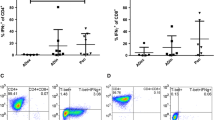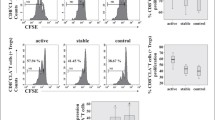Abstract
Alopecia areata is characterized by peribulbar infiltration by activated T cells. The function of these T cells in the pathogenesis is unknown. To elucidate the potential role of lesional T cells in the regulation of hair growth, T-cell clones from the margin of involved alopecia areata lesions from three patients were obtained by cloning, using the limiting dilution method. Of these T-cell clones, 31 were CD4 + CD8 – , 15 were CD8 + CD4 – and 2 were CD4 – CD8 – . The T-cell clones were activated and the supernatant harvested 24 h later and tested for its capacity to regulate proliferation of neonatal keratinocytes. The majority of the T-cell clone supernatants inhibited epithelial cell proliferation in a dose-dependent fashion. When the cytokine profiles of conditioned T-cell medium were compared with the growth-regulatory capacity, it was found that T-cell clones that released high amounts of interferon gamma and/or tumour necrosis factor alpha inhibited keratinocyte growth. In conclusion, T cells derived from the margin of active alopecia areata lesions are able to downregulate epithelial cell proliferation. This points to an important role of the immune system, especially the T cells, in this disease.
Similar content being viewed by others
Author information
Authors and Affiliations
Additional information
Received: 28 May 1996
Rights and permissions
About this article
Cite this article
Thein, C., Strange, P., Hansen, E. et al. Lesional alopecia areata T lymphocytes downregulate epithelial cell proliferation. Arch Dermatol Res 289, 384–388 (1997). https://doi.org/10.1007/s004030050209
Issue Date:
DOI: https://doi.org/10.1007/s004030050209




